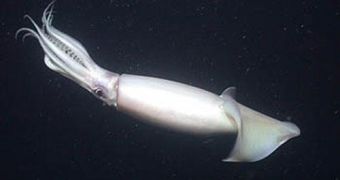Global warming and overfishing come with unpleasant surprises. Packs of aggressive and large squids have invaded waters off California's central coast, destroying local fish populations.
Humboldt or jumbo squid (Dosidicus gigas) is an aggressive carnivore up to six feet (2 m) long and 100 pounds (45 kg) nicknamed "the red devil" because it attacks everything; cases of attacked divers have been recorded. This squid first appeared off Monterey, California during an El Ni?o event which increased water temperatures in 1997, but since 2002 they have taken up permanent residence.
"I think we're seeing the combined results of climate change and overfishing. There has been a big change in the cast of characters out there that may be very significant commercially as well as ecologically." says Bruce Robison of the Monterey Bay Aquarium Research Institute in California, US.
The Humboldt squid normally inhabits warm ocean currents northwards from the tropical waters off Central America and Mexico only during El Ni?o outbursts. In the northern areas they would prey on Pacific hake, a fish up to one meter long, but they would retire to the tropics when the El Ni?o warming ended.
"Overfishing of tuna in the tropics has caused squid populations to rise. This occurs because tuna feed on the same smaller fish that squid eat, and also prey on young squid, keeping the population in check." said Robison.
The growing squid population has now spread northwards as the ocean temperatures have risen. But the dumbo squids, even if large beasts, are hard to track down as during the day they inhabit deep waters, at 600 - 1,300 ft (200 - 430 m).
But in 1989, the Monterey Bay Aquarium Research Institute began monthly transects in the bay's deep waters with uncrewed remotely-operated submersibles, filled with high-tech sensing equipment, like high definition video and sonar that picked up the squid in an instant.
"We wanted to get a handle on the composition, structure and variability of the whole ocean community and how it changes over time. We didn't expect to find a story this dramatic when we began." said Robison.
Individuals captured in California had ear bones of hake and other fish in their stomachs.
"They are aggressive, pugnacious, voracious, predators. The creatures grow from the size of a person's little finger up to two metres in length and 45 kilograms in weight in a year, and are known to eat their own kind." said Robison.
There is a legend created around them hinting that they would be man-eating.
"I don't think they consider humans fair game." added Robison, but during the night, the beasts ascend above 600 feet (200 m), and this is where divers have had nasty encounters with them.

 14 DAY TRIAL //
14 DAY TRIAL //